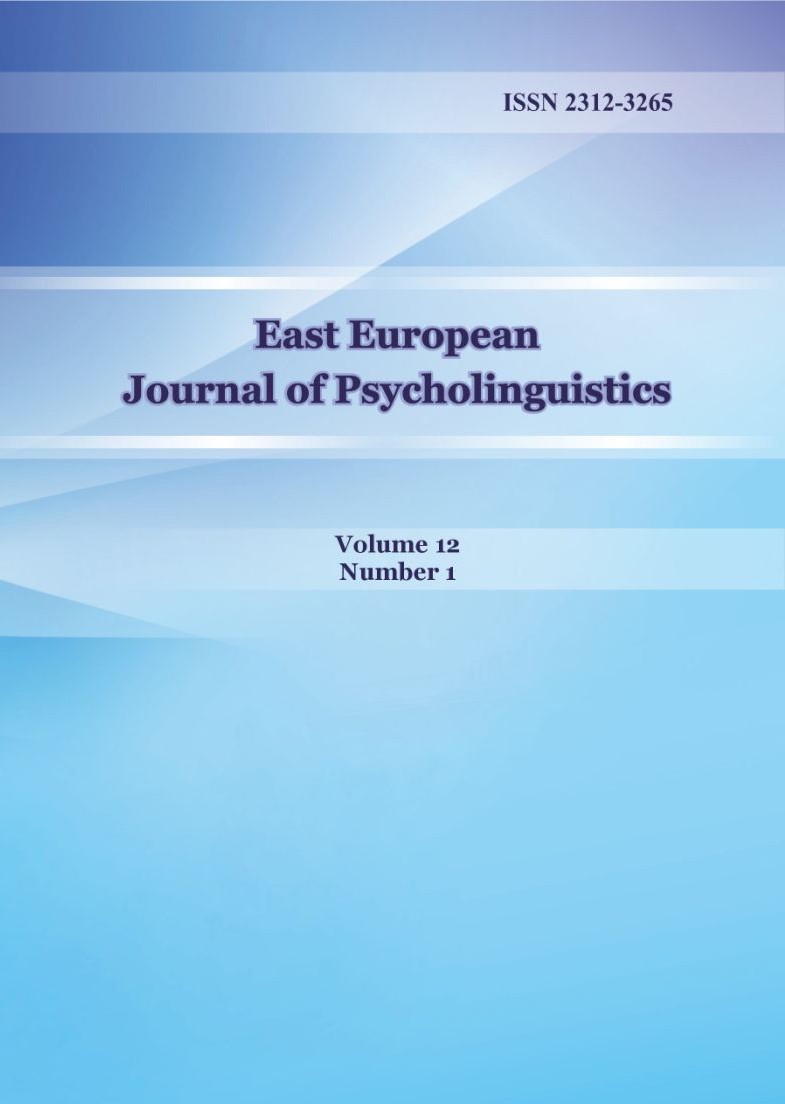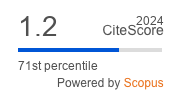Психолінгвістика перекладу: Лексико-синтаксичні процеси в турецько-англійському контексті
DOI:
https://doi.org/10.29038/eejpl.2025.12.1.kasКлючові слова:
переклад, психолінгвістика, синтаксична перебудова, метакогнітивні стратегії, протокол "Міркуй уголос"Анотація
Це дослідження аналізує когнітивні процеси, що лежать в основі перекладу з турецької на англійську мову, залучивши 41 студента, які вивчають англійську мову як іноземну (EFL) на рівні вище середнього (B2 CEFR) і беруть участь у програмі викладання англійської мови. Використовуючи внутрішньосуб'єктний дизайн, учасники виконували лексичні (когнати, «удавані друзі», низькочастотні одиниці) та синтаксичні (перебудова SOV→SVO) перекладацькі завдання, застосовуючи протокол «міркуй уголос». Кількісний та якісний аналіз виявив: (1) полегшення когнатів (92% точності) завдяки орфографічно-семантичному перекриттю, протидіяло якому втручання «удаваних друзів» (64% точності), що вимагало пригніченого контролю; (2) синтаксичну складність у реструктуризації (наприклад, відносні речення: точність 52%), з подовженим часом обробки (+40%), що відображає когнітивне навантаження; та (3) метакогнітивні стратегії (концептуальний моніторинг, придушення мови1) як ключові предиктори успіху. Результати дослідження підкреслюють взаємодію декларативних і процедурних знань у перекладі, акцентуючи увагу на педагогічних висновках для метакогнітивного навчання та аналізу помилок на основі корпусу в турецько-англійському контексті.
Завантажити
Посилання
Aitchison, J. (2012). Words in the mind: An introduction to the mental lexicon (4th ed.). Wiley-Blackwell.
Bernolet, S., Hartsuiker, R. J., & Pickering, M. J. (2013). From language-specific to shared syntactic representations: The influence of second language proficiency on syntactic sharing in bilinguals. Cognition, 127(3), 287–306. https://doi.org/10.1016/j.cognition.2013.02.005
Boguslawska-Tafelska, M. (2001). Psycholinguistic Mechanisms in Translation. Acta Neophilologia, 3, 11–24.
De Groot, A. M. B., & Nas, G. L. J. (1991). Lexical representation of cognates and noncognates in compound bilinguals. Journal of Memory and Language, 30(1), 90–123. https://doi.org/10.1016/0749-596X(91)90016-9
Demir, C., & Akyel, A. (2022). Syntactic challenges in Turkish-English translation: A focus on adverbial clauses. Journal of Psycholinguistic Research, 51(4), 873–896. https://doi.org/10.1007/s10936-022-09861-z
Dijkstra, T., & Van Heuven, W. J. B. (2002). The architecture of the bilingual word recognition system: From identification to decision. Bilingualism: Language and Cognition, 5(3), 175–197. https://doi.org/10.1017/S1366728902003012
Duyck, W., Van Assche, E., Drieghe, D., & Hartsuiker, R. J. (2007). Visual word recognition by bilinguals in a sentence context: Evidence for nonselective lexical access. Journal of Experimental Psychology: Learning, Memory, and Cognition, 33(4), 663–679. https://doi.org/10.1037/0278-7393.33.4.663
Ehrlich, S. F., & Rayner, K. (1981). Contextual effects on word perception and eye movements during reading. Journal of Verbal Learning and Verbal Behavior, 20(6), 641-655.
Ericsson, K. A., & Simon, H. A. (1993). Protocol analysis: Verbal reports as data (Rev. ed.). MIT Press.
Fromkin, V., Rodman, R., & Hyams. N. (2018). An Introduction to Language (11th Asia ed.). Cengage Publishing.
García, A. M. (2019). Translation and neurocognitive research: A systematic review. Translation, Cognition & Behavior, 2(1), 1–20. https://doi.org/10.1075/tcb.00012.gar
Green, D. W. (1998). Mental control of the bilingual lexico-semantic system. Bilingualism: Language and Cognition, 1(2), 67–81. https://doi.org/10.1017/S1366728998000133
Hartsuiker, R. J., Pickering, M. J., & Veltkamp, E. (2004). Is syntax separate or shared between languages? Psychological Science, 15(6), 409–414. https://doi.org/10.1111/j.0956-7976.2004.00693.x
Jiang, N. (2000). Lexical representation and development in a second language. Applied Linguistics, 21(1), 47–77. https://doi.org/10.1093/applin/21.1.47
Jessner, U. (2008). A DST model of multilingualism and the role of metalinguistic awareness. Modern Language Journal, 92(2), 270–283. https://doi.org/10.1111/j.1540-4781.2008.00718.x
Kornfilt, J. (1997). Turkish. Routledge.
Kroll, J. F., & Stewart, E. (1994). Category interference in translation and picture naming: Evidence for asymmetric connections between bilingual memory representations. Journal of Memory and Language, 33(2), 149–174. https://doi.org/10.1006/jmla.1994.1008
Kroll, J. F., Van Hell, J. G., Tokowicz, N., & Green, D. W. (2010). The revised hierarchical model: A critical review and assessment. Bilingualism: Language and Cognition, 13(3), 373–381. https://doi.org/10.1017/S136672891000009X
Levelt, W. J. M. (1989). Speaking: From intention to articulation. MIT Press.
Martín, R.M., & Apfelthaler, M., (2022). A task segment framework to study keylogged translation processes. International Journal for Translation and Interpreting. 14 (2) DOI:10.12807/ti.114202.2022.a02
Özçelik, Ö., & Sprouse, J. (2021). L1 transfer in L2 acquisition of relative clauses: Evidence from Turkish learners of English. Second Language Research, 37(3), 431–456. https://doi.org/10.1177/0267658320928469
Selinker, L. (1972). Interlanguage. International Review of Applied Linguistics in Language Teaching, 10(1-4), 209–241. https://doi.org/10.1515/iral.1972.10.1-4.209
Şahin, M. (2021). Lexical mediation in advanced L2 learners: Evidence from Turkish-English bilinguals. TESOL Quarterly, 55(3), 789–817. https://doi.org/10.1002/tesq.3030
Ullman, M. T. (2001). The neural basis of lexicon and grammar in first and second language: The declarative/procedural model. Bilingualism: Language and Cognition, 4(2), 105–122. https://doi.org/10.1017/S1366728901000220
Appendix A
Lexical Task (15 Turkish Sentences)
Objective: Test lexical access by targeting cognates, false friends, and semantically dense vocabulary.
1. Orijinal fikrini paylaştı. (Cognate: "orijinal" → "original")
2. Aktüel haberleri izliyorum. (False friend: "aktüel" ≠ "actual" [→ "current"])
3. Kontrolü kaybetti. (Cognate: "kontrol" → "control")
4. Randevumu iptal ettim. (Semantically dense: "iptal" → "cancel")
5. Doktor reçete yazdı. (Low-frequency: "reçete" → "prescription")
6. Fabrika üretimi durdurdu. (Cognate: "fabrika" → "factory")
7. Ambivalans hissettim. (False friend: "ambivalans" ≠ "ambulance" [→ "ambivalence"])
8. Tramvay durağı nerede? (Culture-specific: "tramvay" → "tram")
9. Global sorunlar hakkında konuştuk. (Cognate: "global" → "global")
10. Realist bir yaklaşım sergiledi. (False friend: "realist" ≠ "realistic")
11. Parfüm kokusu çok keskin. (Non-cognate: "keskin" → "sharp")
12. Dijital platformları kullanıyor. (Cognate: "dijital" → "digital")
13. İzolasyon beni yordu. (False friend: "izolasyon" ≠ "isolation" [→ "loneliness"])
14. Analiz sonuçları açıklandı. (Cognate: "analiz" → "analysis")
15. Kritik bir hataydı. (False friend: "kritik" ≠ "critic" [→ "critical"])
Rationale:
• Sentences 1, 3, 6, 9, 12, 14 test cognate facilitation (Kroll & Stewart, 1994).
• Sentences 2, 7, 10, 13, 15 elicit false friend interference (Aitchison, 2012).
• Sentences 4, 5, 8, 11 assess semantic depth (Levelt, 1989).
Appendix B
Syntactic Task (15 Turkish Sentences)
Objective: Test syntactic processing by requiring SOV→SVO restructuring and clause embedding.
1. Elmaları yıkadım. (SOV → SVO: "I washed the apples.")
2. Öğretmen ödevleri kontrol etti. (SOV → SVO + definite article: "The teacher checked the homework.")
3. Bana verdiğin kitap ilginçti. (Embedded clause → relative clause: "The book you gave me was interesting.")
4. Parkta koşan çocuk düştü. (Subject-modifying clause: "The child running in the park fell.")
5. Arabasını satan adam üzgündü. (Object-modifying clause: "The man who sold his car was sad.")
6. Yemek yaparken telefon çaldı. (Adverbial clause: "While cooking, the phone rang.")
7. Hediye aldığım arkadaşım geldi. (Possessive + embedded clause: "The friend I bought a gift for arrived.")
8. Şarkı söyleyen kızı dinledik. (Direct object clause: "We listened to the girl singing.")
9. Kapıyı açan kişiyi tanımıyorum. (Relative clause with object focus: "I don’t know the person who opened the door.")
10. Yağmur yağınca şemsiyemi aldım. (Adverbial causality: "When it rained, I took my umbrella.")
11. Bilgisayarını tamir eden teknisyen burada. (Subject-modifying clause with possession: "The technician who fixed your computer is here.")
12. Annemin pişirdiği yemeği yedim. (Double embedding: "I ate the meal my mother cooked.")
13. Sınavı geçen öğrenciler kutladı. (Subject-verb agreement: "The students who passed the exam celebrated.")
14. Söylediklerini duydun mu? (Object-fronted clause: "Did you hear what they said?")
15. Gitmeden önce ışıkları kapat. (Adverbial + imperative: "Turn off the lights before leaving.")
Rationale:
• Sentences 1–2 test basic word order restructuring.
• Sentences 3–9 target embedded clause processing (Bock & Levelt, 1994).
• Sentences 10–15 examine complex syntax integration (Juffs & Harrington, 1995
Завантаження
Опубліковано
Номер
Розділ
Ліцензія
Авторське право (c) 2025 Süleyman Kasap, Nazim Işık

Ця робота ліцензується відповідно до ліцензії Creative Commons Attribution 4.0 International License.











 Creative Commons «Attribution» 4.0
Creative Commons «Attribution» 4.0